Visualizing translocation dynamics and nascent transcript errors in paused RNA polymerases in vivo
- PMID: 25976475
- PMCID: PMC4457086
- DOI: 10.1186/s13059-015-0666-5
Visualizing translocation dynamics and nascent transcript errors in paused RNA polymerases in vivo
Erratum in
-
Erratum to: Visualizing translocation dynamics and nascent transcript errors in paused RNA polymerases in vivo.Genome Biol. 2015 Dec 2;16:270. doi: 10.1186/s13059-015-0845-4. Genome Biol. 2015. PMID: 26631078 Free PMC article. No abstract available.
Abstract
Background: Transcription elongation is frequently interrupted by pausing signals in DNA, with downstream effects on gene expression. Transcription errors also induce prolonged pausing, which can lead to a destabilized genome by interfering with DNA replication. Mechanisms of pausing associated with translocation blocks and misincorporation have been characterized in vitro, but not in vivo.
Results: We investigate the pausing pattern of RNA polymerase (RNAP) in Escherichia coli by a novel approach, combining native elongating transcript sequencing (NET-seq) with RNase footprinting of the transcripts (RNET-seq). We reveal that the G-dC base pair at the 5' end of the RNA-DNA hybrid interferes with RNAP translocation. The distance between the 5' G-dC base pair and the 3' end of RNA fluctuates over a three-nucleotide width. Thus, the G-dC base pair can induce pausing in post-translocated, pre-translocated, and backtracked states of RNAP. Additionally, a CpG sequence of the template DNA strand spanning the active site of RNAP inhibits elongation and induces G-to-A errors, which leads to backtracking of RNAP. Gre factors efficiently proofread the errors and rescue the backtracked complexes. We also find that pausing events are enriched in the 5' untranslated region and antisense transcription of mRNA genes and are reduced in rRNA genes.
Conclusions: In E. coli, robust transcriptional pausing involves RNAP interaction with G-dC at the upstream end of the RNA-DNA hybrid, which interferes with translocation. CpG DNA sequences induce transcriptional pausing and G-to-A errors.
Figures
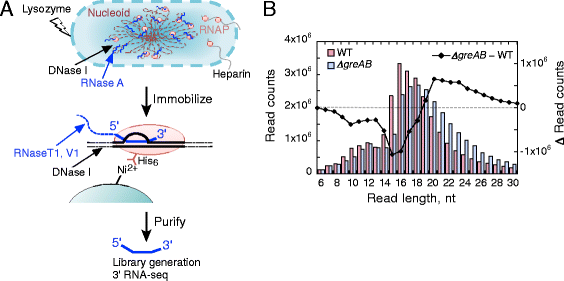
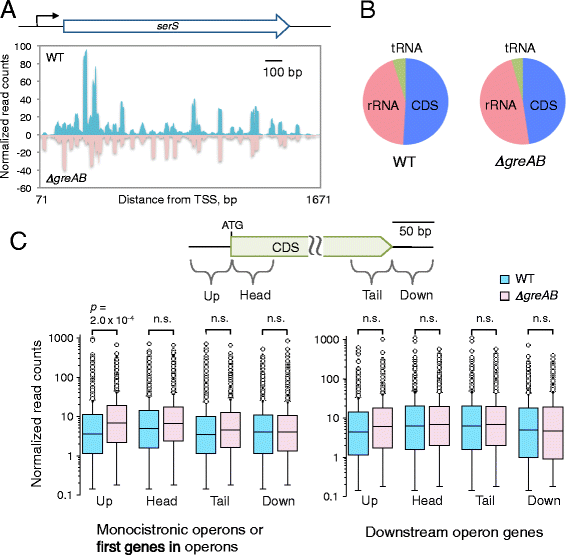
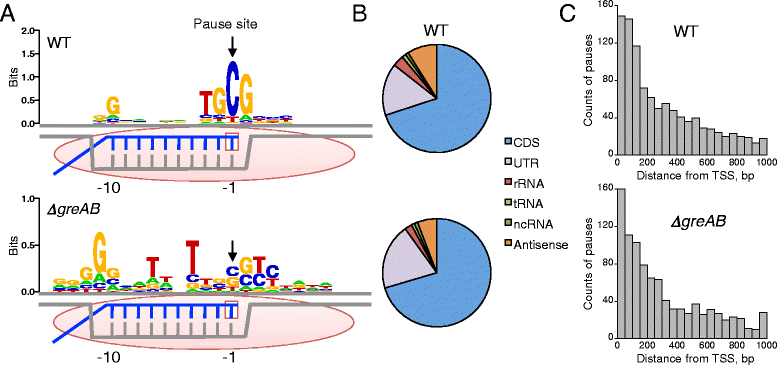

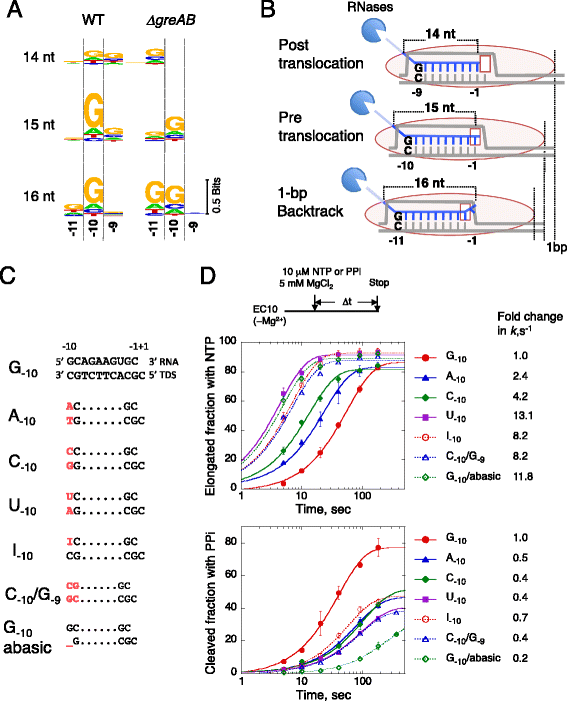
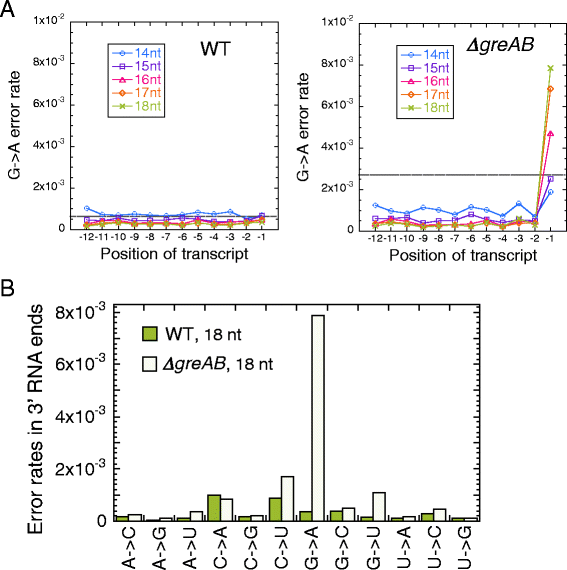
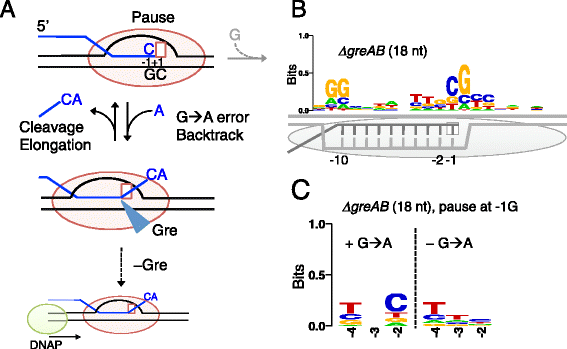
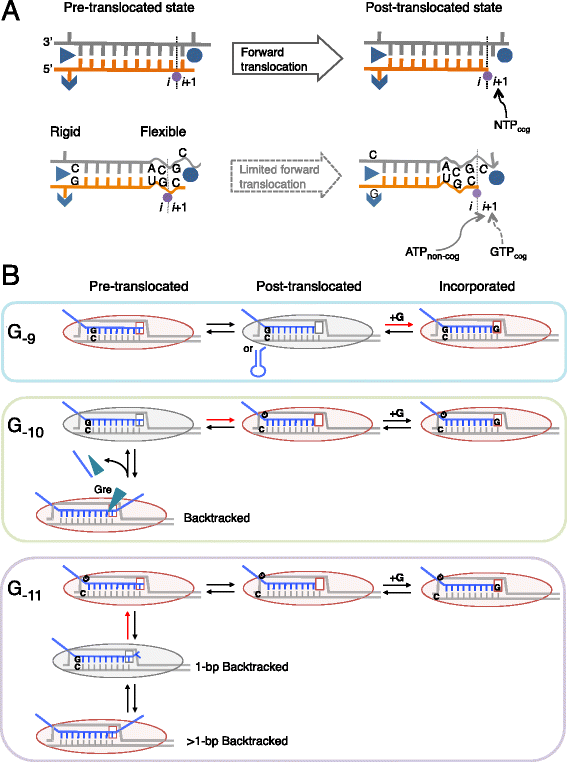
Similar articles
-
NusG controls transcription pausing and RNA polymerase translocation throughout the Bacillus subtilis genome.Proc Natl Acad Sci U S A. 2020 Sep 1;117(35):21628-21636. doi: 10.1073/pnas.2006873117. Epub 2020 Aug 17. Proc Natl Acad Sci U S A. 2020. PMID: 32817529 Free PMC article.
-
Transcriptome-Wide Effects of NusA on RNA Polymerase Pausing in Bacillus subtilis.J Bacteriol. 2022 May 17;204(5):e0053421. doi: 10.1128/jb.00534-21. Epub 2022 Mar 8. J Bacteriol. 2022. PMID: 35258320 Free PMC article.
-
Structural transitions in the transcription elongation complexes of bacterial RNA polymerase during σ-dependent pausing.Nucleic Acids Res. 2012 Apr;40(7):3078-91. doi: 10.1093/nar/gkr1158. Epub 2011 Dec 2. Nucleic Acids Res. 2012. PMID: 22140106 Free PMC article.
-
The yin and yang of the universal transcription factor NusG.Curr Opin Microbiol. 2024 Oct;81:102540. doi: 10.1016/j.mib.2024.102540. Epub 2024 Sep 2. Curr Opin Microbiol. 2024. PMID: 39226817 Review.
-
NusG/Spt5: are there common functions of this ubiquitous transcription elongation factor?Curr Opin Microbiol. 2014 Apr;18:68-71. doi: 10.1016/j.mib.2014.02.005. Epub 2014 Mar 12. Curr Opin Microbiol. 2014. PMID: 24632072 Free PMC article. Review.
Cited by
-
Transcription fidelity: New paradigms in epigenetic inheritance, genome instability and disease.DNA Repair (Amst). 2019 Sep;81:102652. doi: 10.1016/j.dnarep.2019.102652. Epub 2019 Jul 8. DNA Repair (Amst). 2019. PMID: 31326363 Free PMC article. Review.
-
Gre factors-mediated control of hilD transcription is essential for the invasion of epithelial cells by Salmonella enterica serovar Typhimurium.PLoS Pathog. 2017 Apr 20;13(4):e1006312. doi: 10.1371/journal.ppat.1006312. eCollection 2017 Apr. PLoS Pathog. 2017. PMID: 28426789 Free PMC article.
-
A link between transcription fidelity and pausing in vivo.Transcription. 2017 Mar 15;8(2):99-105. doi: 10.1080/21541264.2016.1274812. Epub 2017 Jan 10. Transcription. 2017. PMID: 28072558 Free PMC article.
-
NusG-dependent RNA polymerase pausing is a frequent function of this universally conserved transcription elongation factor.Crit Rev Biochem Mol Biol. 2020 Dec;55(6):716-728. doi: 10.1080/10409238.2020.1828261. Epub 2020 Oct 2. Crit Rev Biochem Mol Biol. 2020. PMID: 33003953 Free PMC article.
-
The World of Stable Ribonucleoproteins and Its Mapping With Grad-Seq and Related Approaches.Front Mol Biosci. 2021 Apr 7;8:661448. doi: 10.3389/fmolb.2021.661448. eCollection 2021. Front Mol Biosci. 2021. PMID: 33898526 Free PMC article. Review.
References
Publication types
MeSH terms
Substances
Associated data
- Actions
Grants and funding
LinkOut - more resources
Full Text Sources
Other Literature Sources
Molecular Biology Databases

